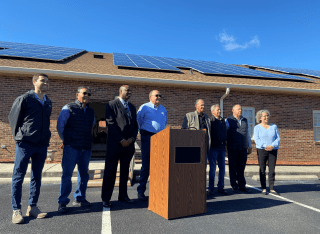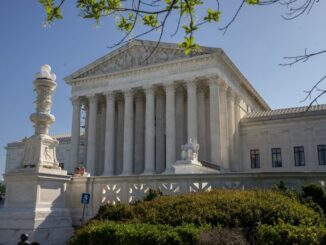
A rush of applications in the final months of a Duke Energy solar rebate program reflects an ongoing need to help North Carolina nonprofits share the benefits of clean energy, advocates say.
Duke Energy received 140 applications from nonprofits in the last two months of 2022 — nearly as many as benefited from the rebates in the program’s first four years.
“Nonprofits woke up to the power of the Duke rebate, for sure,” said Laura Combs, senior sales associate with Eagle Solar and Light, who focuses on outreach to organizations in disadvantaged areas around the state.
But the program — which offered a cash-back option for congregations, schools, and other tax-exempt organizations that haven’t been able to directly claim clean energy tax credits — was winding down just as it was catching on.
With the Duke rebates now expired, Combs and other solar advocates are searching for new ways to fill the void — especially for the Black, Brown and low-wealth communities that many say stand the most to gain from clean energy.
“Nonprofits don’t have the money. Oftentimes, nonprofits are just barely making it,” said Bishop William Barber II, a former head of the North Carolina NAACP who leads a new social justice training center at Yale Divinity School. “What we don’t want to see is all the investment going into solar, but the very communities that get hurt the most don’t benefit from it.”
Sign up for Energy News Weekly
Get the most important energy news of the week delivered directly to your inbox.
‘Investment ought to be there first’
Like many Black churches in the South, Greenleaf Christian Church in Goldsboro was established just after the end of the Civil War — its congregants were once enslaved laborers on the fertile coastal plain.
“This church was founded by former slaves,” said Barber, the pastor there for nearly 30 years before stepping down in December. “When they built the first sanctuary, it was a brush shelter.”
The church’s first pastor walked to Raleigh, the state capital, to demand a new name unconnected to his enslaver, said Barber. “He was a very forward-thinking man,” he said, just one reason Greenleaf long “has tended to think about church beyond just Sunday.”
In 1996, early in Barber’s tenure, that thinking meant the establishment of Rebuilding Broken Places Community Development Corporation. “We needed to be a church that says, ‘We’re going to at least attempt to make a difference,’” he said.
Three years later, Rebuilding Broken Places gained official nonprofit status. It now claims the creation of more than $15 million in assets through low-income family homeownership, childcare and after-school programs, a community kitchen, and more.
When Eagle Solar and Light approached the group about taking advantage of Duke’s rebates — up to 75 cents per kilowatt-hour of capacity — and working with Sunwealth, a mission-driven for-profit company that finances solar installations, the math was impossible to resist, said John Barnes, the executive director of Rebuilding Broken Places since 2003.
“Three years ago, we were talking about it, and today we’re flipping the switch,” Barnes said last November, at a dedication for the organization’s two new rooftop arrays. “We paid no money upfront.”
“Let’s put our hands in. Somebody get this picture,” said Bishop William Barber II, at the dedication of new solar panels at Rebuilding Broken Places, in Goldsboro, North Carolina. “Let’s say: ‘God needs our hands.’” Credit: Eagle Solar and Light / CourtesyJohn Barnes, executive director of Rebuilding Broken Places in Goldsboro, North Carolina, after flipping the switch on the nonprofit’s new solar panels. Credit: Elizabeth Ouzts
Eagle Solar and Light installed the two systems of 115 kilowatts, earning over $81,000 in Duke Energy rebates. That money covered a down payment to Sunwealth, which bought the solar panels and charges monthly for their use. Rebuilding Broken Places expects to save upwards of $10,000 per year on electricity.
Rooftop solar ties in easily to the church’s mission, Barber said. “When we see the life of Jesus, he was always caring for community. Anything that helps cut pollution, anything that helps save the planet — it’s a part of our calling.”
What’s more, said Barber, the solar array allows the community center to set an example, and to use money once used for fossil-fuel power for other parts of the organization’s mission.
Without question, he said, the solar array wouldn’t have happened without the Duke rebate.
But the program — and others that will hopefully secede it — shouldn’t be viewed as a handout, but an investment.
“Poor and low-wealth communities are the first that are impacted by the negatives of climate change,” Barber said, “and investment ought to be there first.”
‘Who better to tell the story?’
James Hardin, a Lumbee Indian and executive director of the Lumbee Regional Development Association in Pembroke, also believes marginalized communities should get priority in the clean energy transition. And American Indians, he said, should play a special role because of their long connection to the land. “Who better to tell the story of saving the planet?” he said.
An early investor in a solar farm that earns about $20,000 a year, according to its tax returns, Hardin’s nonprofit has “more history and core knowledge about renewables than any other tribe [or] nonprofit Indian organization in the Southeast,” he said.
Yet like Rebuilding Broken Places, the Lumbee Regional Development Association has slim operating margins, spending most of its annual grant income on its small business incubator and other programs in one of the most impoverished regions in the state.
That’s why the Duke Energy rebate was the difference maker for the nonprofit’s 76-kilowatt rooftop array, honored in a dedication ceremony last month. Eagle Solar and Light also installed those panels, financed by Sunwealth.
“We will get a check from Duke power for $56,250,” Hardin explained. “That check will be signed over to Sunwealth. With no money required upfront and an estimated $8,200 in annual savings, he said, “it’s a no-brainer from that standpoint.”
Jordan Swett, a Lumbee Indian with family in Robeson County, is a project finance manager for Sunwealth based in New York. “Our mission is to democratize the benefits of clean energy,” Swett told the crowd at the Pembroke ceremony. “Being a Lumbee and having the opportunity to work on this project — I love the fact we’re not just bringing clean energy to the community. We’re also helping to reinvest in the community through the savings that the system creates.”
Greg Richardson, the director of the state’s Commission of Indian Affairs and a member of the Haliwa-Saponi Indian Tribe, expects the Lumbee Regional Development Association could set an example for other tribes in the state. “What we hope to do is bring the same type of effort into other tribal communities,” Richardson said at the ceremony. “It is so much needed.”
‘A lot to take on’
But without the Duke rebate program — a requirement of a 2017 state law that the company has no plans to renew — options for nonprofit entities wanting to go solar are limited.
The U.S. Department of Energy offers grants for tribal energy efficiency and renewable energy projects — but only federally recognized tribes are eligible to apply. North Carolina’s only such tribe is the Eastern Band of Cherokee Indians. The Lumbee, the Haliwa-Saponi, and five more tribes, concentrated in some of the state’s most impoverished counties, don’t have that advantage.
The Inflation Reduction Act, the climate law that was passed last year, does create some new possibilities. It renewed a 30% tax credit for rooftop solar purchases and allowed organizations with no tax liability to monetize the credit as a rebate. Investments in designated brownfield or fossil fuel communities using domestic supplies can yield up to 50% cash back.
“The challenge comes in floating the entire cost of a solar installation while waiting for the federal government to pay your 30% to 50%,” said Eagle Solar and Light’s Combs. “That’s a lot to take on.”
Plus, some nonprofits will struggle to install solar even with the help of cash back from the government: They simply lack the capital to make down payments that will ensure an immediate return on their investment. A new $27 billion Greenhouse Gas Reduction Fund created by the climate law could devote resources to these entities, said Adam Kent, a senior advisor at the Natural Resources Defense Council.
“It is a very clear priority of this program to drive dollars to greenhouse gas-reducing projects in low-income and marginalized communities,” said Kent. The U.S. Environmental Protection Agency announced last week that the competition for the funds will be held this summer.
While Combs explores these federal opportunities, she’s also looking to state lawmakers, who convened their legislative session last month. One item on her wish list: getting a drop of North Carolina’s anticipated $3 billion surplus dedicated to rooftop solar projects to nonprofits in the state’s 50 most impoverished counties.
One way or another, Combs, who last year won an award from the North Carolina Sustainable Energy Association for her commitment to diversity and inclusion, is determined to help organizations in need.
“It feels weird to even make money doing this,” she said. “I can help protect the planet and help people that the industry has largely ignored. I get to work with the people that are really making a difference in a big way. It’s really inspiring.”



